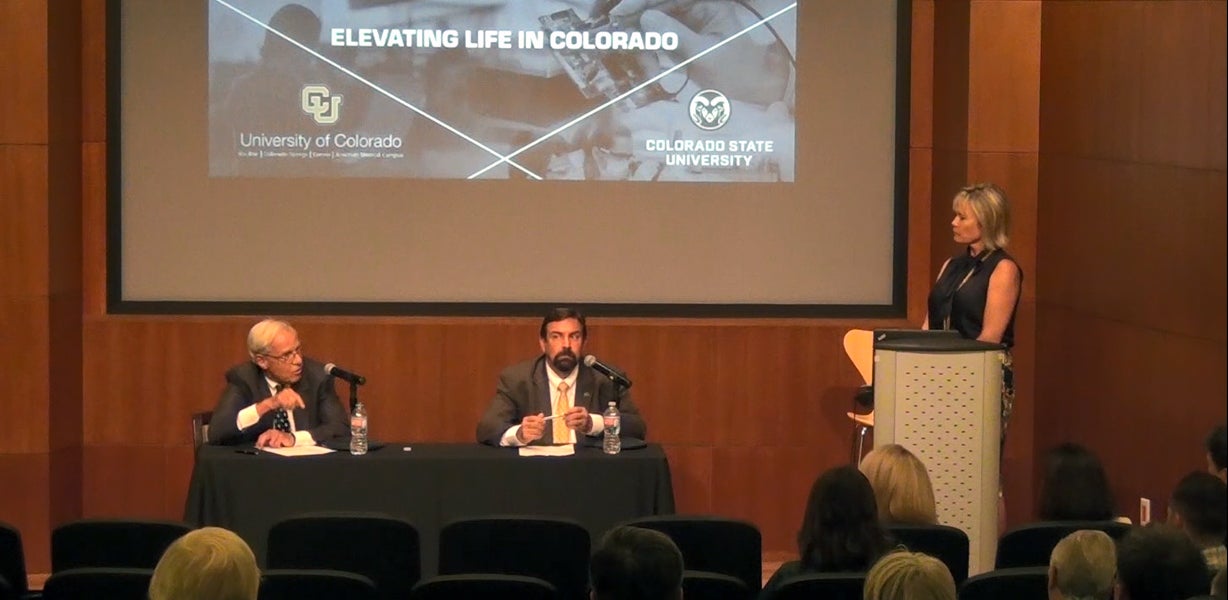Collaboration a constant for state’s premier research universities

The competition between the University of Colorado and Colorado State University often generates the bigger headlines – like last Friday’s Rocky Mountain Showdown between the Buffs and Rams.
Before and after the games, though, the state’s two premier research universities go about the quieter work of elevating life in Colorado. Such enterprise often takes place in collaboration, such as cancer research at the CU Anschutz Medical Campus in Aurora and CSU’s Flint Animal Cancer Center in Fort Collins, or the CU Anschutz-based Colorado School of Public Health, powered by CU, CSU and the University of Northern Colorado.
The leaders of CU and CSU came together Aug. 30 to tout the value of such efforts and take stock of challenges facing the institutions. CU President Bruce Benson and CSU President Tony Frank appeared before an audience of 120 business and civic leaders, including CU Regent Glen Gallegos, at the Denver Post Education Forum, held at the newspaper's downtown Denver offices.
“Our two universities have great stories to tell,” Frank said.
“Occasionally we disagree, and that’ll be Friday night,” Benson said with a smile. But the leaders emphasized areas of agreement, such as recognizing a need to stress the tremendous value that CU and CSU add to the state’s economy, health and culture.
Benson noted the high level of satisfaction among CU alumni who took part in a survey last year. More than 95 percent reported they were “very satisfied” or “somewhat satisfied” with their CU education. On average, more than two-thirds of those were in the “very satisfied” category.
“What we’ve got to get across to people is that we are still pretty much a bargain,” Benson said. “Think about the cost of education compared to the cost of a car. A car depreciates while the value of education appreciates.”
Benson and Frank acknowledged that state funding challenges have required universities to seek greater operating efficiencies and increase tuition. But they refuted the notion that student debt is debilitating to Colorado graduates.
Benson highlighted how student debt at CU and CSU are below the national average.
“That debt is not as onerous as a lot of people think. Default rates on loans are lower, too,” Benson said. “The national average is around 10 percent, the state is around 10 or 11 percent, and we’re around 3 percent. Why? Because (our graduates) get jobs.”
Panel moderator Molly Hughes asked what sets apart research universities such as CU and CSU from primarily teaching universities and other colleges.
“At CU, we have undergraduate students controlling satellites, working in labs with researchers,” Benson said. Industry and business “still need really high-quality employees. … People have to understand that’s what we’re supplying.”
Said Frank, “At both our institutions, we create new knowledge, pass it on to the next generation, and apply it. They’re more than just words. We don’t believe those things are just simultaneous – we believe they’re synergistic.
“As Bruce points out, when you can put students in a laboratory as undergraduates … you see some really powerful things happening. My guess is we’re going to see that really accelerate for the next one or two decades.”
By having two premier research universities within close geographic proximity, the region enjoys a “cluster of innovation,” Frank said, much like Silicon Valley. He cited a Department of Commerce study that examined “innovation economics.”
“The single biggest factor they found was the presence of two or more research universities within a certain physical proximity. Colorado has that,” said Frank, who noted the additional presence of the Colorado School of Mines, national laboratories and federal scientists. “These universities are a critical part of setting up Colorado to really compete in the knowledge economy in the 21st century. CU and CSU bring a lot to the table … In terms of the collaboration, I don’t think there’s a lot we can do that’s more important than create this economic ecosystem that will position Colorado so well as we go forward.”
At CU, Benson said he stresses collaboration within a single campus, between all four campuses and between CU and other institutions.
“We’re always looking for ways to help each other and collaborate,” Benson said.
Said Frank, “Across Colorado … you see universities that have really tried to knock down barriers and say, hey, if you can find a way to work with someone else and make progress, more power to you. Let us know how we can help. I think you see that reflected in both our administrations.”
Benson agreed.
“I think you see it all over the place. It’s critical that people operate like that,” Benson said. “It’s our business model. I’m a business guy. You have to work with other people and build trust with each other.”

